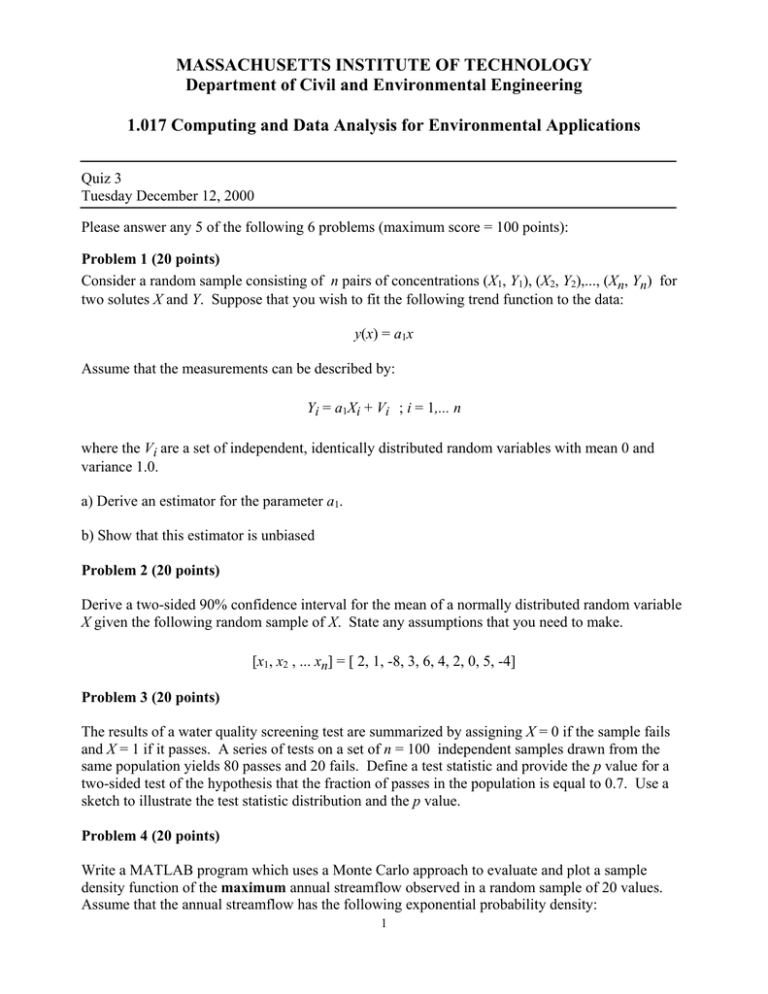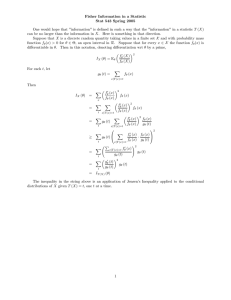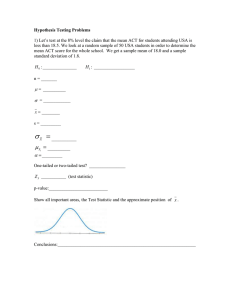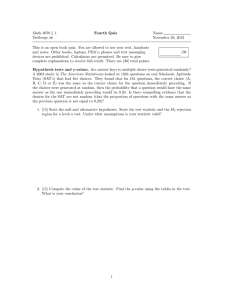MASSACHUSETTS INSTITUTE OF TECHNOLOGY Department of Civil and Environmental Engineering
advertisement

MASSACHUSETTS INSTITUTE OF TECHNOLOGY Department of Civil and Environmental Engineering 1.017 Computing and Data Analysis for Environmental Applications Quiz 3 Tuesday December 12, 2000 Please answer any 5 of the following 6 problems (maximum score = 100 points): Problem 1 (20 points) Consider a random sample consisting of n pairs of concentrations (X1, Y1), (X2, Y2),..., (Xn, Yn) for two solutes X and Y. Suppose that you wish to fit the following trend function to the data: y(x) = a1x Assume that the measurements can be described by: Yi = a1Xi + Vi ; i = 1,... n where the Vi are a set of independent, identically distributed random variables with mean 0 and variance 1.0. a) Derive an estimator for the parameter a1. b) Show that this estimator is unbiased Problem 2 (20 points) Derive a two-sided 90% confidence interval for the mean of a normally distributed random variable X given the following random sample of X. State any assumptions that you need to make. [x1, x2 , ... xn] = [ 2, 1, -8, 3, 6, 4, 2, 0, 5, -4] Problem 3 (20 points) The results of a water quality screening test are summarized by assigning X = 0 if the sample fails and X = 1 if it passes. A series of tests on a set of n = 100 independent samples drawn from the same population yields 80 passes and 20 fails. Define a test statistic and provide the p value for a two-sided test of the hypothesis that the fraction of passes in the population is equal to 0.7. Use a sketch to illustrate the test statistic distribution and the p value. Problem 4 (20 points) Write a MATLAB program which uses a Monte Carlo approach to evaluate and plot a sample density function of the maximum annual streamflow observed in a random sample of 20 values. Assume that the annual streamflow has the following exponential probability density: 1 1 x exp − ; x ≥ 0 a a f X ( x) = 0 ; otherwise f X ( x) = where a is the mean annual streamflow. The probability distribution of the maximum for this case is an example of an extreme value distribution. Suppose that the mean and maximum streamflows obtained from 20 actual annual stream flow measurements are 10 m3/sec and 50 m3/sec. How would you use your program to estimate the probability of obtaining, in another 20 year sample, a maximum greater than 50 m3/sec.? Problem 5 (20 points) Suppose that you are given the MATLAB function ahatcdf(aval,a) which returns the cumulative distribution function (CDF) value of a test statistic ahat for any value aval of this statistic. The test statistic is used to test hypotheses about the distributional property a of a sampled random variable X (e.g a could be the mean of X). Note that the CDF of ahat depends on the parameter a. You are also given a function ahat(x) that returns the ahat (test statistic) value obtained from a particular random sample of X. The n measurements in the sample are assembled in an n vector x. a) Write a MATLAB function pvalue which returns the p value for a one-sided test of the hypothesis H0: a = 1 vs. the alternative H1: a > 1 The data vector x should be passed to pvalue through the function argument. b) Suppose that ahat is a positive continuous random variable (e.g. a sum of squares). Sketch a hypothetical probability density function of ahat showing the H0 acceptance region (A0) for the hypothesis test in Part a). Indicate on your sketch the relationship between the p value and the value of ahat derived from the sample x. Problem 6 (20 points) Suppose that you wish to test the hypothesis H0: θ = 0 vs. the alternative H1: θ = 1. You have derived that the probability distribution function of your test statistic given H0: θ = 0 is normal with mean 0.0 and variance 1. Also, you have derived that the probability distribution function of your test statistic given H1: θ = 1 is normal with mean 1.0 and variance 4. What are the Type I and Type II error probabilities if your H0 acceptance region is A0 = [-∞, 0.5]? Provide a sketch which identifies each of these probabilities. 2






